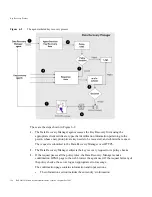
Testing Your OCSP Setup
184
Red Hat Certificate System Administrator’s Guide • September 2005
port<n>.
Type the nonSSL port of the LDAP directory. For example, 389.
baseDN<n>.
Type the DN to start searching for the CRL. For example,
O=example.com
.
refreshInSec<n>.
Type how often the connection is refreshed. The default is
86400 seconds (that is, refresh every day).
caCertAttr.
Leave the default value,
cACertificate;binary
, as it is. (It’s the
attribute to which the Certificate Manager publishes its CA signing certificate.)
crlAttr.
Leave the default value,
certificateRevocationList;binary
, as it
is. (It’s the attribute to which the Certificate Manager publishes CRLs.)
notFoundAsGood.
A certificate’s status can typically be indicated by three
possible OCSP responses, namely GOOD, REVOKED, and UNKNOWN. Select
this option if you want the Online Certificate Status Manager to return an OCSP
response of GOOD if the certificate in question cannot be found in any of the
CRLs. If you deselect the option, the response will be UNKNOWN, which when
encountered by Red Hat Personal Security Manager (an OCSP-compliant client)
results in an error message.
includeNextUpdate.
The Online Certificate Status Manager can include the time
stamp of next CRL update—a future update time for the CRL or the revocation
information—in the OCSP response that it sends to OCSP-compliant clients.
(According to the OCSP protocol, it is optional to include the time stamp of next
CRL update in an OCSP response.) Select this option if you want the OCSP
response to contain information about the next CRL update. Leave the option
deselected if you don’t want the OCSP response to contain this information.
6.
Click OK.
You’re returned to the Revocation Store Info Management tab
7.
Click Refresh.
Testing Your OCSP Setup
To test whether the Certificate Manager can service OCSP requests properly, follow these
steps:
1.
Turn On Revocation Checking in your browser or client.
2.
Request a certificate from the CA that has been enabled for OCSP services.
3.
Approve the request.
Summary of Contents for CERTIFICATE 7.1 ADMINISTRATOR
Page 1: ...Administrator s Guide Red Hat Certificate System Version7 1 September 2005 ...
Page 22: ...22 Red Hat Certificate System Administrator s Guide September 2005 ...
Page 128: ...Cloning a CA 128 Red Hat Certificate System Administrator s Guide September 2005 ...
Page 368: ...ACL Reference 368 Red Hat Certificate System Administrator s Guide September 2005 ...
Page 460: ...Constraints Reference 460 Red Hat Certificate System Administrator s Guide September 2005 ...
Page 592: ...CRL Extension Reference 592 Red Hat Certificate System Administrator s Guide September 2005 ...






























